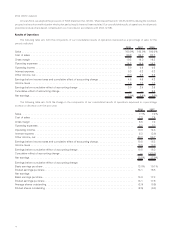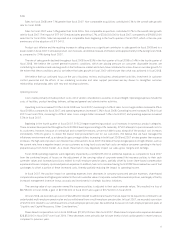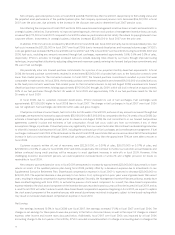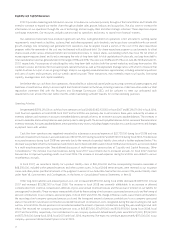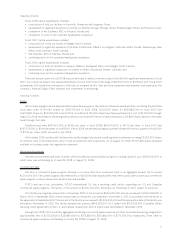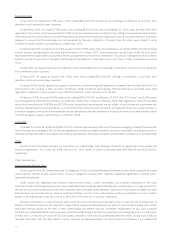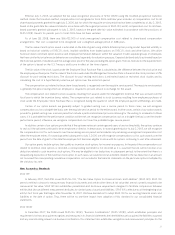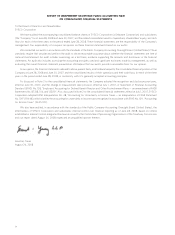Sysco 2008 Annual Report Download - page 48
Download and view the complete annual report
Please find page 48 of the 2008 Sysco annual report below. You can navigate through the pages in the report by either clicking on the pages listed below, or by using the keyword search tool below to find specific information within the annual report.(5)
Includes payments on floating rate debt based on rates as of June 28, 2008, assuming amount remains unchanged until maturity, and
payments on fixed rate debt based on maturity dates.
(6)
For purposes of this table, purchase obligations include agreements for purchases of product in the normal course of business, for which
all significant terms have been confirmed, including minimum quantities resulting from our sourcing initiative. Such amounts included
in the table above are based on estimates. Purchase obligations also includes amounts committed with a third party to provide
hardware and hardware hosting services over a ten year period ending in fiscal 2015 (See discussion under Note 18, Commitments and
Contingencies, in the Notes to Consolidated Financial Statements in Item 8), fixed electricity agreements and fixed fuel purchase
commitments. Purchase obligations exclude full requirements electricity contracts where no stated minimum purchase volume is
required.
Certain acquisitions involve contingent consideration, typically payable only in the event that certain operating results are attained or
certain outstanding contingencies are resolved. Aggregate contingent consideration amounts outstanding as of June 28, 2008 included
$55,469,000 in cash. This amount is not included in the table above.
No obligations were included in the table above for the qualified retirement plan because as of June 28, 2008, we do not have a
minimum funding requirement under ERISA guidelines for this plan due to our previous voluntary contributions. However, we intend to make
voluntary contributions to the qualified retirement plan totaling $80,000,000 during fiscal 2009.
Critical Accounting Policies and Estimates
The preparation of financial statements in conformity with generally accepted accounting principles requires us to make estimates and
assumptions that affect the reported amounts of assets, liabilities, sales and expenses in the accompanying financial statements. Significant
accounting policies employed by SYSCO are presented in the notes to the financial statements.
Critical accounting policies and estimates are those that are most important to the portrayal of our financial condition and results of
operations. These policies require our most subjective or complex judgments, often employing the use of estimates about the effect of
matters that are inherently uncertain. We have reviewed with the Audit Committee of the Board of Directors the development and selection
of the critical accounting policies and estimates and this related disclosure. Our most critical accounting policies and estimates pertain to the
allowance for doubtful accounts receivable, self-insurance programs, company-sponsored pension plans, income taxes, vendor consid-
eration, accounting for business combinations and share-based compensation.
Allowance for Doubtful Accounts
We evaluate the collectability of accounts receivable and determine the appropriate reserve for doubtful accounts based on a
combination of factors. We utilize specific criteria to determine uncollectible receivables to be written off, including whether a customer has
filed for or has been placed in bankruptcy, has had accounts referred to outside parties for collection or has had accounts past due over
specified periods. Allowances are recorded for all other receivables based on analysis of historical trends of write-offs and recoveries. In
addition, in circumstances where we are aware of a specific customer’s inability to meet its financial obligation, a specific allowance for
doubtful accounts is recorded to reduce the receivable to the net amount reasonably expected to be collected. Our judgment is required as to
the impact of certain of these items and other factors as to ultimate realization of our accounts receivables. If the financial condition of our
customers were to deteriorate, additional allowances may be required.
Self-Insurance Program
We maintain a self-insurance program covering portions of workers’ compensation, general liability and vehicle liability costs. The
amounts in excess of the self-insured levels are fully insured by third party insurers. We also maintain a fully self-insured group medical
program. Liabilities associated with these risks are estimated in part by considering historical claims experience, medical cost trends,
demographic factors, severity factors and other actuarial assumptions. Projections of future loss expenses are inherently uncertain because
of the random nature of insurance claims occurrences and could be significantly affected if future occurrences and claims differ from these
assumptions and historical trends. In an attempt to mitigate the risks of workers’ compensation, vehicle and general liability claims, safety
procedures and awareness programs have been implemented.
Company-Sponsored Pension Plans
Amounts related to defined benefit plans recognized in the financial statements are determined on an actuarial basis. Three of the more
critical assumptions in the actuarial calculations are the discount rate for determining the current value of plan benefits, the assumption for
the rate of increase in future compensation levels and the expected rate of return on plan assets.
For guidance in determining the discount rates, we calculate the implied rate of return on a hypothetical portfolio of high-quality fixed-
income investments for which the timing and amount of cash outflows approximates the estimated payouts of the pension plan. The
discount rate assumption is reviewed annually and revised as deemed appropriate.The discount rate for determining fiscal 2008 net pension
costs for the company-sponsored qualified pension plan (Retirement Plan), which was determined as of the June 30, 2007 measurement
date, increased 0.05% to 6.78%. The discount rate for determining fiscal 2008 net pension costs for the SERP, which was determined as of
24


